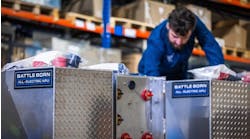After the harsh winter storms and a wet, soggy spring, trucks and equipment are rolling into summer in a little worse shape than before. Bad weather is tough on fleets and equipment with repairs costing up to $15,000 on average, annually.
Maintaining vehicles – including repair, upkeep and downtime, has a huge impact on a company’s bottom line, and it’s crucial for fleet and equipment managers to keep vehicles in tip-top shape. Not only can a good maintenance program help increase uptime for vehicles and equipment, it can also prevent operator injuries and even fatalities. With summer on the horizon, it’s time to clean up those vehicles and get them back into the shop for a maintenance checkup. During this time, fleet and equipment managers can find ways to improve overall fleet and equipment management by updating their maintenance process for the coming year.
By assessing and updating three key areas, fleet and equipment managers can create a proactive, preventive maintenance program to help keep their operating costs to a minimum and make sure their driver and operators are safe while on the road this summer.
1. Using the Right Tools
Going digital helps drivers, operators and fleet and equipment managers easily and quickly manage their vehicle inspection process and meet compliance standards. Most maintenance and inspection processes are still done with pen and paper, and it can take up to two weeks to send, collect and store information which can delay vehicles from getting back on the road. Consider using a solution like Zonar’s Electronic Verified Inspection Reporting (EVIR®) which automatically captures, transmits and records inspection, compliance and maintenance data. By shifting from paper-based inspections to the EVIR system, fleet and equipment managers can reduce the processing time for inspections by more than 50 percent.
2. Maintaining a Schedule
Focusing on preventative measures (instead of reactively dealing with problems) helps fleet an equipment managers ensure all vehicles get the attention they need and reduce fleet and equipment operating costs, decrease the number of break downs on the road, and trips to the shop. Utilizing remote diagnostics helps automate maintenance scheduling based on vehicle or equipment usage and integrations with maintenance systems. When diagnostics are combined with electronic trip reports that alert maintenance about serious defects mere seconds after the driver or operator sees them, fleet and equipment managers can create a preventive maintenance program built around the needs of each specific vehicle. This process allows fleet and equipment managers to prioritize work, order parts, schedule shop time, and plan labor resources to complete repairs more quickly. As a result, fleet and equipment managers decrease maintenance costs and increase uptime.
3. Tracking Fuel Economy
Driver behavior has a direct and costly impact on fuel costs and vehicle operation. Smooth and steady use of cruise control, high RPMs, and smart idling directly correlate to fuel consumption—and are all within the driver’s control. There are solutions that can help drivers and fleet and equipment managers keep an eye on their fuel usage and identify trends and behaviors that can help or hurt performance. For example, ZFuel® can help managers plan and forecast for maximum efficiency, and even assess and reward drivers for following best practices. Preventative behavior can go a long way in ensuring maintenance inspections go smoothly.
Ben Franklin was right: an ounce of prevention is worth a pound of cure. Good maintenance programs take into account preventative measures and not simply focus on repairing what needs to be fixed. By using the right tools (and going digital), keeping to a schedule, and tracking fuel economy, fleet, equipment managers and driver/operators can not only save money and time but also gain peace of mind knowing they’re prepared for the coming year.


